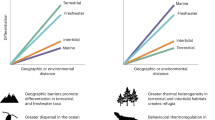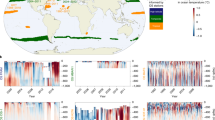Abstract
Temperature profoundly affects species’ geographic ranges, but the extent to which it limits contemporary range edges has been difficult to assess from laboratory experiments of thermal tolerance. The persistence of populations depends on temperature-mediated outcomes of ecological and demographic processes across all stages of a species’ life history, as well as any adaptation to local temperature regimes. We assessed the relationships between sea temperature and observed distributional ranges for 1,790 shallow-water marine species from 10 animal classes and found remarkable consistencies in trends in realized thermal limits among taxa and ocean basins, as well as general agreement with previous laboratory findings. Realized thermal niches increase from the Equator towards cold–temperate locations, despite an opposite trend in geographic range size. Species’ cool distribution limits are best predicted by the magnitude of seasonality within their range, while a relatively firm thermal barrier exists on the equatorward range edge for temperate species. Our findings of consistencies in realized thermal limits indicate potential limits to adaptation among common marine species and highlight the value of realized thermal niches for predicting species’ distributional dynamics in warming seas.
This is a preview of subscription content, access via your institution
Access options
Access Nature and 54 other Nature Portfolio journals
Get Nature+, our best-value online-access subscription
$29.99 / 30 days
cancel any time
Subscribe to this journal
Receive 12 digital issues and online access to articles
$119.00 per year
only $9.92 per issue
Buy this article
- Purchase on Springer Link
- Instant access to full article PDF
Prices may be subject to local taxes which are calculated during checkout


Similar content being viewed by others
References
Tittensor, D. P. et al. Global patterns and predictors of marine biodiversity across taxa. Nature 466, 1098–1101 (2010).
Chen, I.-C., Hill, J. K., Ohlemüller, R., Roy, D. B. & Thomas, C. D. Rapid range shifts of species associated with high levels of climate warming. Science 333, 1024–1026 (2011).
Woodward, F. I. Climate and Plant Distribution (Cambridge Univ. Press, Cambridge, 1987).
Edgar, G. et al. Abundance and local-scale processes contribute to multi-phyla gradients in global marine diversity. Sci. Adv. (in the press).
Lee-Yaw, J. A. et al. A synthesis of transplant experiments and ecological niche models suggests that range limits are often niche limits. Ecol. Lett. 19, 710–722 (2016).
Stuart-Smith, R. D., Edgar, G. J., Barrett, N. S., Kininmonth, S. J. & Bates, A. E. Thermal biases and vulnerability to warming in the world’s marine fauna. Nature 528, 88–92 (2015).
Gaston, K. J. & Fuller, R. A. The sizes of species’ geographic ranges. J. Appl. Ecol. 46, 1–9 (2009).
Sexton, J. P., McIntyre, P. J., Angert, A. L. & Rice, K. J. Evolution and ecology of species range limits. Annu. Rev. Ecol. Evol. Syst. 40, 415–436 (2009).
Sunday, J. M., Bates, A. E. & Dulvy, N. K. Global analysis of thermal tolerance and latitude in ectotherms. Proc. R. Soc. B 278, 1823–1830 (2011).
Araújo, M. B. et al. Heat freezes niche evolution. Ecol. Lett. 16, 1206–1219 (2013).
Pörtner, H. O. & Farrell, A. P. Physiology and climate change. Science 322, 690–692 (2008).
Pörtner, H. Climate change and temperature-dependent biogeography: oxygen limitation of thermal tolerance in animals. Naturwissenschaften 88, 137–146 (2001).
Addo-Bediako, A., Chown, S. L. & Gaston, K. J. Thermal tolerance, climatic variability and latitude. Proc. R. Soc. Lond. B 267, 739–745 (2000).
Tewksbury, J. J., Huey, R. B. & Deutsch, C. A. Putting the heat on tropical animals. Science 320, 1296–1297 (2008).
Janzen, D. H. Why mountain passes are higher in the tropics. Am. Nat. 101, 233–249 (1967).
Stevens, G. C. The latitudinal gradient in geographical range: how so many species coexist in the tropics. Am. Nat. 133, 240–256 (1989).
Payne, N. L. & Smith, J. A. An alternative explanation for global trends in thermal tolerance. Ecol. Lett. 20, 70–77 (2017).
Mora, C. et al. High connectivity among habitats precludes the relationship between dispersal and range size in tropical reef fishes. Ecography 35, 89–96 (2012).
Payne, N. L. et al. Temperature dependence of fish performance in the wild: links with species biogeography and physiological thermal tolerance. Funct. Ecol. 30, 903–912 (2016).
Papacostas, K. J. & Freestone, A. L. Latitudinal gradient in niche breadth of brachyuran crabs. Glob. Ecol. Biogeogr. 25, 207–217 (2016).
Roy, K., Jablonski, D. & Valentine, J. W. Eastern Pacific molluscan provinces and latitudinal diversity gradient: no evidence for “Rapoport’s rule”. Proc. Natl Acad. Sci. USA 91, 8871–8874 (1994).
Rohde, K., Heap, M. & Heap, D. Rapoport’s rule does not apply to marine teleosts and cannot explain latitudinal gradients in species richness. Am. Nat. 142, 1–16 (1993).
Edgar, G. J. & Stuart-Smith, R. D. Systematic global assessment of reef fish communities by the Reef Life Survey program. Sci. Data 1, 140007 (2014).
Sandblom, E. et al. Physiological constraints to climate warming in fish follow principles of plastic floors and concrete ceilings. Nat. Commun. 7, 11447 (2016).
Gaston, K. J., Blackburn, T. M. & Spicer, J. I. Rapoport’s rule: time for an epitaph? Trends Ecol. Evol. 13, 70–74 (1998).
Pörtner, H. O. Climate variations and the physiological basis of temperature dependent biogeography: systemic to molecular hierarchy of thermal tolerance in animals. Comp. Biochem. Physiol. A 132, 739–761 (2002).
Sunday, J. M. et al. Species traits and climate velocity explain geographic range shifts in an ocean-warming hotspot. Ecol. Lett. 18, 944–953 (2015).
Poloczanska, E. S. et al. Global imprint of climate change on marine life. Nat. Clim. Change 3, 919–925 (2013).
Figueira, W. F., Biro, P., Booth, D. J. & Valenzuela, V. C. Performance of tropical fish recruiting to temperate habitats: role of ambient temperature and implications of climate change. Mar. Ecol. Prog. Ser. 384, 231–239 (2009).
Last, P. R. et al. Long-term shifts in abundance and distribution of a temperate fish fauna: a response to climate change and fishing practices. Glob. Ecol. Biogeogr. 20, 58–72 (2011).
O’Connor, M. I. et al. Temperature control of larval dispersal and the implications for marine ecology, evolution, and conservation. Proc. Natl Acad. Sci. USA 104, 1266–1271 (2007).
Gaylord, B. & Gaines, S. D. Temperature or transport? Range limits in marine species mediated solely by flow. Am. Nat. 155, 769–789 (2000).
Angert, A. L., Sheth, S. N. & Paul, J. R. Incorporating population-level variation in thermal performance into predictions of geographic range shifts. Integr. Comp. Biol. 51, 733–750 (2011).
Bennett, S., Wernberg, T., Arackal Joy, B., de Bettignies, T. & Campbell, A. H. Central and rear-edge populations can be equally vulnerable to warming. Nat. Commun. 6, 10280 (2015).
Sanford, E. & Kelly, M. W. Local adaptation in marine invertebrates. Annu. Rev. Mar. Sci. 3, 509–535 (2011).
Pulliam, H. R. Sources, sinks, and population regulation. Am. Nat. 132, 652–661 (1988).
Gunderson, A. R. & Stillman, J. H. Plasticity in thermal tolerance has limited potential to buffer ectotherms from global warming. Proc. R. Soc. B 282, 20150401 (2015).
Stuart-Smith, R. D. et al. Integrating abundance and functional traits reveals new global hotspots of fish diversity. Nature 501, 539–542 (2013).
Spanier, E. & Galil, B. S. Lessepsian migration: a continuous biogeographical process. Endeavour 15, 102–106 (1991).
Campbell, H. A., Fraser, K. P. P., Bishop, C. M., Peck, L. S. & Egginton, S. Hibernation in an Antarctic fish: on ice for winter. PLoS ONE 3, e1743 (2008).
Masuda, R. Seasonal and interannual variation of subtidal fish assemblages in Wakasa Bay with reference to the warming trend in the Sea of Japan. Env. Biol. Fish. 82, 387–399 (2008).
Edgar, G. J. & Barrett, N. S. Effects of the declaration of marine reserves on Tasmanian reef fishes, invertebrates and plants. J. Exp. Mar. Biol. Ecol. 242, 107–144 (1999).
Costello, M. J., Darwall, W. R. & Lysaght, S. in Biology and Ecology of Shallow Coastal Waters: Proc. 28th European Marine Biology Symp., Institute of Marine Biology of Crete, Iraklio, Crete, 1993 (eds Eleftheriou, A., Smith, C. & Ansell, A. D.) 343–350 (Olsen & Olsen, Fredensborg, 1995).
Bates, A. E. et al. Defining and observing stages of climate-mediated range shifts in marine systems. Glob. Environ. Change 26, 27–38 (2014).
Booth, D. J., Figueira, W. F., Gregson, M. A., Brown, L. & Beretta, G. Occurrence of tropical fishes in temperate southeastern Australia: role of the East Australian Current. Estuar. Coast. Shelf Sci. 72, 102–114 (2007).
Orton, J. H. Sea-temperature, breeding and distribution in marine animals. J. Mar. Biol. Assoc. India 12, 339–366 (1920).
Hutchins, L. W. The bases for temperature zonation in geographical distribution. Ecol. Monogr. 17, 325–335 (1947).
Comte, L. & Olden, J. D. Climatic vulnerability of the world's freshwater and marine fishes. Nat. Clim. Change 7, 718–722 (2017).
García Molinos, J. et al. Climate velocity and the future global redistribution of marine biodiversity. Nat. Clim. Change 6, 83–88 (2016).
Burrows, M. T. et al. Geographical limits to species-range shifts are suggested by climate velocity. Nature 507, 492–495 (2014).
Burrows, M. T. et al. The pace of shifting climate in marine and terrestrial ecosystems. Science 334, 652–655 (2011).
Peck, L. S. & Conway, L. Z. The myth of metabolic cold adaptation: oxygen consumption in stenothermal Antarctic bivalves. Geol. Soc. Lond. Spec. Publ. 177, 441–450 (2000).
Tyberghein, L. et al. Bio-ORACLE: a global environmental dataset for marine species distribution modelling. Glob. Ecol. Biogeogr. 21, 272–281 (2012).
Strobl, C., Boulesteix, A.-L., Kneib, T., Augustin, T. & Zeileis, A. Conditional variable importance for random forests. BMC Bioinformatics 9, 307 (2008).
Acknowledgements
We thank the many RLS divers who participated in collection of the data used in the analyses and who provide ongoing expertise and commitment to the program, as well as A. Cooper, J. Berkhout, M. Davey, J. Hulls, E. Oh, E. Clausius and J. Stuart-Smith at the University of Tasmania. Development of the RLS was supported by the former Commonwealth Environment Research Facilities Program. Analyses were supported by the Marine Biodiversity Hub—a collaborative partnership supported through the Australian Government’s National Environmental Science Programme—and the Australian Research Council. Additional funding and support for RLS field surveys was provided by grants from The Ian Potter Foundation and Parks Australia.
Author information
Authors and Affiliations
Contributions
R.D.S.-S. and A.E.B. conceived the idea. G.J.E. and R.D.S.-S. assisted with data collection. R.D.S.-S. drafted the manuscript with contributions from A.E.B. and G.J.E. A.E.B. performed the data analysis and prepared the plots.
Corresponding author
Ethics declarations
Competing interests
The authors declare no competing financial interests.
Additional information
Publisher’s note: Springer Nature remains neutral with regard to jurisdictional claims in published maps and institutional affiliations.
Electronic supplementary material
Supplementary Information
Supplementary Tables 1–9, Supplementary Figures 1–3
Rights and permissions
About this article
Cite this article
Stuart-Smith, R.D., Edgar, G.J. & Bates, A.E. Thermal limits to the geographic distributions of shallow-water marine species. Nat Ecol Evol 1, 1846–1852 (2017). https://doi.org/10.1038/s41559-017-0353-x
Received:
Accepted:
Published:
Issue Date:
DOI: https://doi.org/10.1038/s41559-017-0353-x
This article is cited by
-
Marine protected areas promote stability of reef fish communities under climate warming
Nature Communications (2024)
-
Decoding the spread of non-indigenous fishes in the Mediterranean Sea
Scientific Reports (2024)
-
Putting plasticity into practice for effective conservation actions under climate change
Nature Climate Change (2023)
-
Temperate functional niche availability not resident-invader competition shapes tropicalisation in reef fishes
Nature Communications (2023)
-
Stable isotope evidence for a shift in diet with increasing energy demand for reproduction in squid Illex argentinus
Hydrobiologia (2023)



